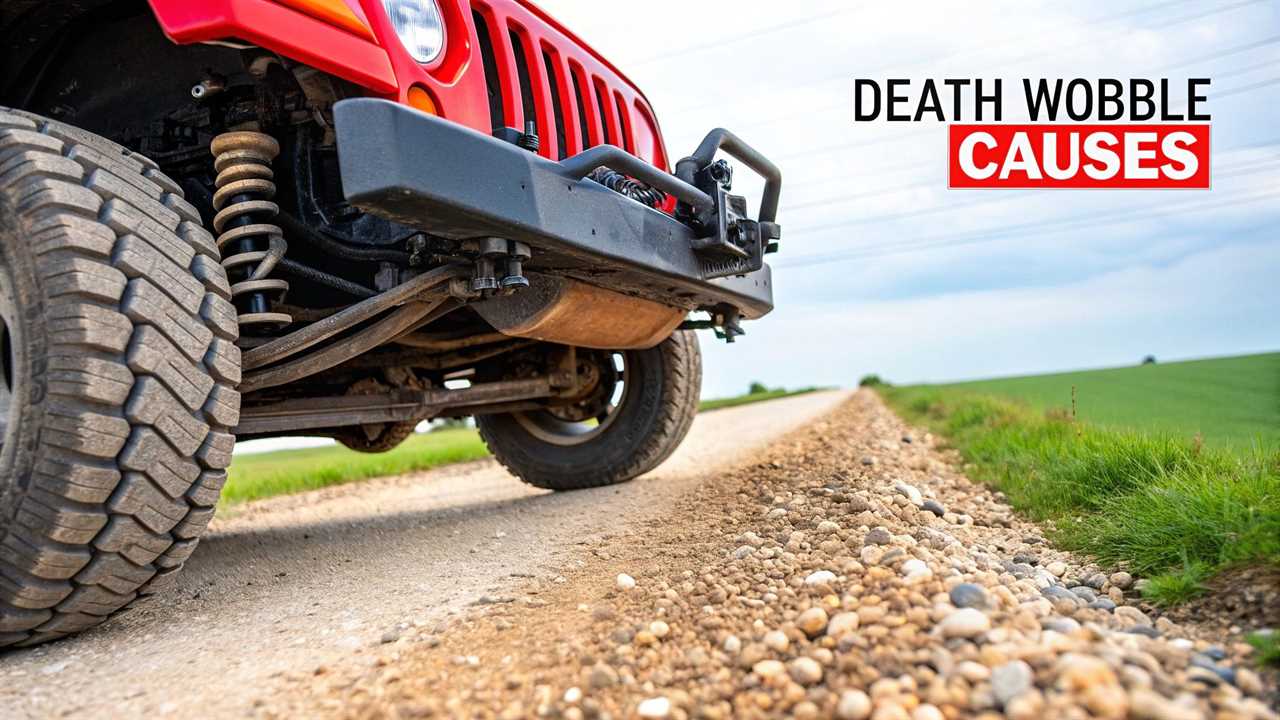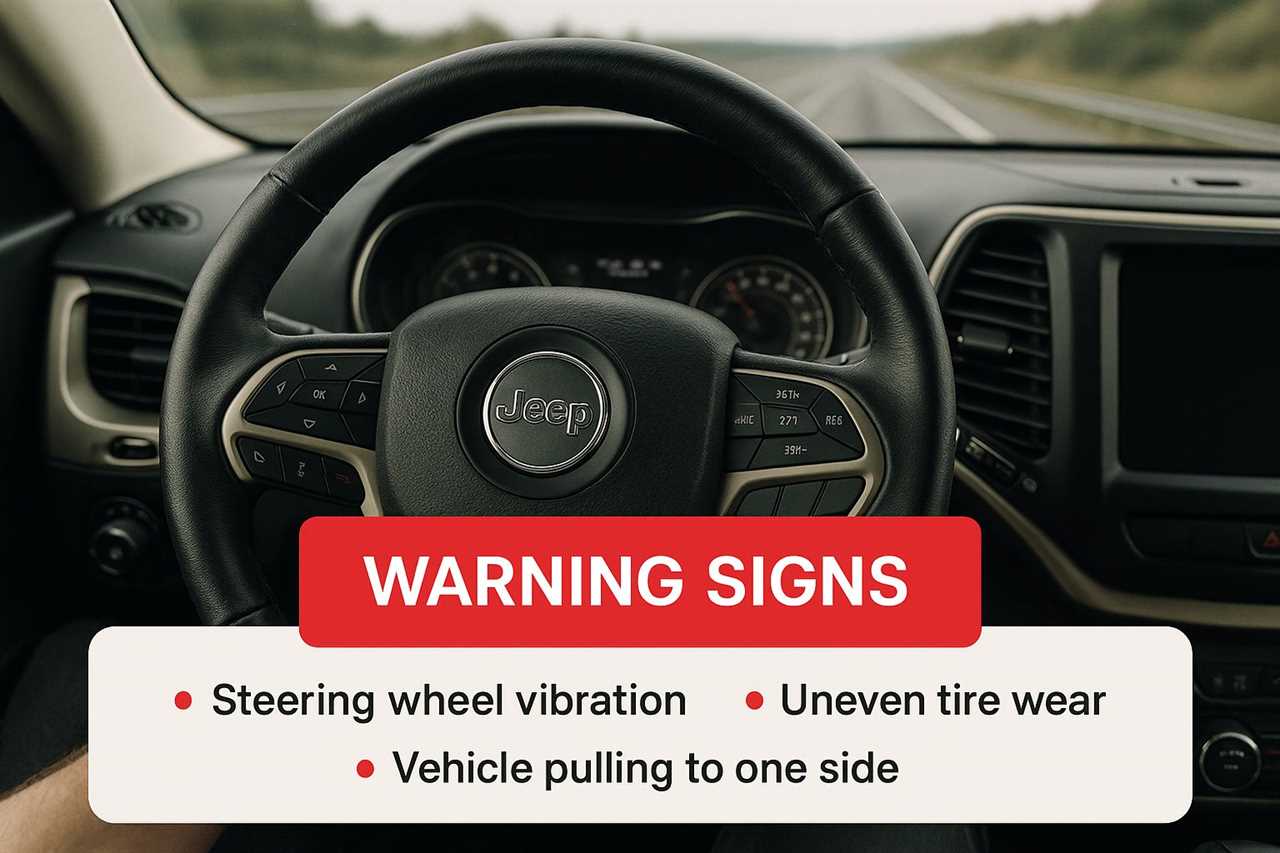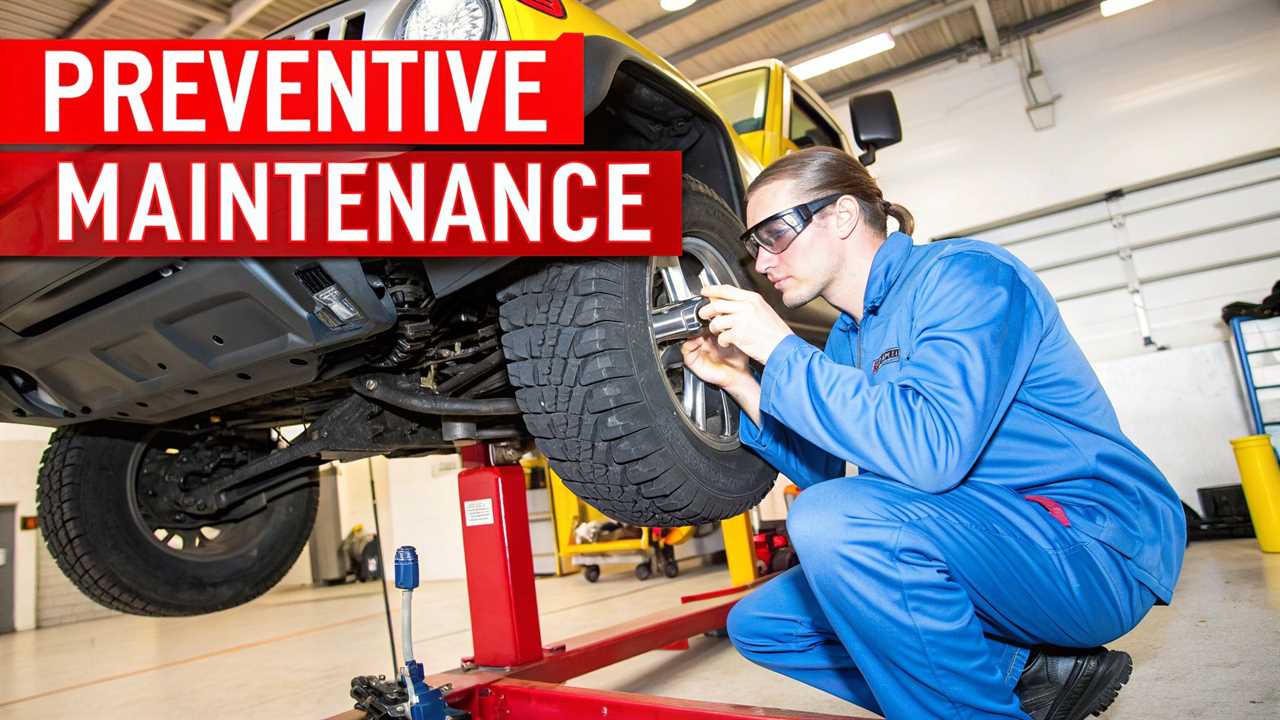Jeep death wobble isn’t just a scary vibration. It’s the direct result of loose, worn out, or damaged parts in your front end. Think of components like the track bar, ball joints, or tie rod ends.
When you hit a bump at speed, that slop in the system allows a violent, uncontrollable shaking to erupt. This isn’t some random fluke; it’s a specific, predictable mechanical failure. The good news is that it can be diagnosed and fixed for good.
Understanding the Infamous Jeep Death Wobble
If you’ve felt it, you know. It’s a terrifying experience that explodes out of nowhere. A sudden, violent oscillation in your steering wheel makes it feel like the entire front end is about to tear itself apart.
To understand it, picture a shopping cart with one wobbly wheel. At a walking pace, it’s a minor annoyance. If you pushed that cart to highway speeds, the wobble would become a chaotic, uncontrollable shake.
The intense vibration is energy from a road impact trapped and amplified within your steering and suspension. This creates a rapid, back-and-forth shimmy that resonates between the tires. It feels like you’ve completely lost control.
Death Wobble Key Symptoms and Triggers
So, what does death wobble actually feel like, and what sets it off? Here’s a quick rundown of the classic signs and triggers every Jeep owner should know.
| Symptom / Trigger |
Description |
| Violent Steering Wheel Shake |
The steering wheel jerks rapidly and violently from side to side. |
| Front-End Vibration |
A powerful shaking or shuddering that feels like it’s coming from the front axle or tires. |
| Feeling of Lost Control |
It feels as if the vehicle is about to fall apart or veer off the road. |
| Hitting a Bump or Pothole |
The most common trigger. A sharp impact at speed is often the catalyst. |
| Highway Speeds |
The wobble rarely occurs at low speeds; it typically starts between 45-70 mph. |
| Braking to Stop It |
The only way to stop the wobble is to slow down significantly, often to a near stop. |
Recognizing these symptoms is the first step. The wobble isn’t a problem with your engine or transmission. It’s a clear signal from your front end that something is seriously wrong.
What Triggers This Violent Shake
This issue isn’t a myth; it’s a well-documented problem that has been around for decades. First widely reported around 1995, it has impacted many drivers. It often happens at highway speeds between 60-70 mph when they hit a bump.
The key takeaway here is that death wobble is not a single part failing. It’s a symptom of a systemic problem in your front suspension. It’s your Jeep’s very loud way of telling you that something is loose and needs immediate attention.
Understanding this turns fear into a solvable problem. To dive deeper into this issue, check out our guide on what a Jeep death wobble is and how to correct it.
The Core Mechanical Reason for Death Wobble

At its heart, the primary cause of Jeep death wobble is the solid front axle. This setup demands that every steering and suspension part works in perfect harmony. When one component gets loose, it becomes the weak link.
That tiny bit of play is all it takes for chaos to kick off. A worn-out part in your front end can no longer properly absorb road forces.
The Chain Reaction of Force
When your Jeep smacks a bump, that energy has to go somewhere. Instead of being dampened, it finds the loose part and starts a feedback loop. This force ricochets between the tires and steering components, creating the shake.
From a mechanical perspective, death wobble results from instability in this solid axle design. When the tires hit an uneven surface, the entire assembly starts to oscillate in what’s known as a shimmy or tramp effect, which continues until you slow down.
Your steering system frantically tries to correct itself but keeps overshooting the mark. This forces the opposite wheel to react, repeating the cycle dozens of times per second. A small worn bushing can trigger this, which is why you might want to learn how to replace bushings on a sway bar.
Finding the Worn Parts That Cause the Wobble
How do you track down the culprit behind your death wobble? It requires a systematic, hands-on inspection of your front end. The root cause is almost always one or more worn-out components.

The earliest clues appear long before a full-blown wobble. A vibrating steering wheel at highway speeds is a classic red flag. Ignoring these warnings can lead to a bigger failure.
Your Diagnostic Checklist
To find the bad actor, you or your mechanic must get under the Jeep. You’ll need to check key parts for any slop or visible damage. The goal is to find any movement that shouldn’t be there.
This process is critical because throwing parts at the problem is a waste of money. It also won’t fix the wobble.
Here are the primary suspects for your checklist:
- Track Bar: This is the #1 cause. Have a friend turn the steering wheel back and forth while you watch the track bar. Look for any side-to-side movement at the bolts and bushings; there should be zero play.
- Ball Joints: Worn ball joints let the steering knuckle wobble. Jack up one front tire and try to wiggle it at the top and bottom (12 and 6 o’clock). Any clunking is a bad sign.
- Tie Rod Ends: Loose tie rod ends create slop in your steering. Grab the tie rod and try to twist it or move it up and down to feel for looseness.
- Control Arm Bushings: These bushings locate your axle. When they crack or wear out, they allow unwanted movement that can trigger a wobble.
Common Worn Components and Their Role in Death Wobble
This table outlines the most common failure points. It shows what they do and how they cause the problem when they go bad.
| Component |
Primary Function |
How Failure Causes Wobble |
| Track Bar |
Centers the axle under the Jeep frame, preventing side-to-side movement. |
Any play allows the entire axle to shift laterally, initiating the violent oscillation of death wobble. |
| Ball Joints |
Act as pivot points for the steering knuckles, allowing the wheels to turn. |
Worn joints let the wheel and tire assembly shimmy and wobble on its vertical axis, feeding into the oscillation. |
| Tie Rod Ends |
Connect the steering components together, translating steering wheel input to the wheels. |
Looseness creates “dead spots” and slop in the steering, preventing the system from staying tight and controlled. |
| Control Arm Bushings |
Secure the axle to the frame and control its fore/aft movement and pinion angle. |
Degraded bushings allow the axle to shift and vibrate, disrupting suspension geometry and stability. |
Remember, while the track bar is the most frequent offender, any of these other parts can be the cause. A thorough inspection is the only way to be sure.
How Aftermarket Lifts and Tires Affect Stability
Lifting your Jeep and adding big tires is a common upgrade. But it’s also a common way to accidentally cause death wobble. Raising your Jeep’s ride height changes the factory suspension and steering geometry.
This change puts new stress on every component, from ball joints to the track bar. Think of it like trying to walk on stilts for the first time. Your center of gravity is higher, and every small wobble feels bigger.
This altered geometry means that factory components are often pushed beyond their limits. A simple 2-inch lift can dramatically change the angle of your track bar, immediately introducing a potential weak point for instability to begin.
This is why a complete, high-quality lift kit is so important. A proper kit includes parts like adjustable track bars and drop pitman arms. These components bring the geometry back into spec.
You can check out different Jeep Wrangler suspension upgrades to see what a full system looks like. Also, don’t forget the tires. Keeping larger tires properly inflated and balanced is critical. A good car air compressor is essential.
A Proactive Maintenance Plan to Prevent Death Wobble

For death wobble, prevention is the best cure. The best way to handle it is to ensure it never starts. This means shifting from fixing broken things to keeping them from breaking.
Think of it as a regular health checkup for your Jeep’s front end. You are hunting for small issues, like a worn bushing or a loose bolt. Finding these early prevents one of the major jeep death wobble causes.
Your Simple Prevention Checklist
Get into the habit of running through these checks every few months. Make it a mandatory ritual after any serious off-road adventure.
- Torque, Torque, Torque: Use a torque wrench on all critical front-end bolts. This includes the track bar, control arms, and steering components. Loose hardware is a top trigger.
- Tire Health: This is a big one. Keep tire pressure correct and rotate them every 5,000 miles. Unbalanced or unevenly worn tires are notorious for starting the wobble.
- Professional Alignment: Get a professional wheel alignment at least once a year. It’s also a must-do after installing a lift kit or new tires.
Frequently Asked Questions About Death Wobble
When dealing with death wobble, you’ll find many myths and bad advice. It can be tough to separate fact from fiction. Let’s tackle the most common questions Jeep owners have.
The goal is not to scare you, but to arm you with the right information. Understanding the mechanics helps you confidently diagnose the root cause. This gets your Jeep back to being safe and reliable.
Can a New Steering Stabilizer Fix Death Wobble?
This is the biggest and most dangerous myth. Many people believe a new, heavy-duty steering stabilizer is the fix. It’s not, and it can make the situation worse.
A steering stabilizer is a small shock absorber for your steering. Its job is to dampen small bumps, not the violent oscillation of death wobble. A beefier one only masks the jeep death wobble causes.
Think of it like taking painkillers for a broken leg. You might not feel the pain, but the bone is still broken. The real problem—a worn track bar or shot ball joints—is still there and will fail again.
Is Death Wobble Only a Jeep Problem?
While “Jeep” and “death wobble” are often linked, it’s not an exclusive problem. Any vehicle with a solid front axle can experience it when parts wear out.
Jeeps are simply the most common poster child due to their popularity and design. You’ll also hear about it in heavy-duty Ford and Dodge Ram trucks. The mechanics are the same: worn components in a solid front axle.
The National Highway Traffic Safety Administration has investigated the phenomenon. No fatal incidents have ever been directly blamed on death wobble. You can find more details at GoodCar.com.
Will My Jeep Fall Apart During a Death Wobble?
It feels like your rig is about to shake to pieces. It’s a terrifying experience. But, it’s extremely unlikely that your front end will actually disintegrate.
The violent shaking is the entire front suspension and steering system resonating out of control. It’s an oscillation, not an immediate catastrophic failure.
The real, immediate danger during a death wobble event is the temporary, but complete, loss of steering control. Your first priority is to slow down smoothly and safely to stop the oscillation and get control back.
At Offroading.com, we provide expert guides and real-world tutorials for any challenge. From diagnosing death wobble to outfitting your rig, we’ve got you covered. Visit Offroading.com to learn more.
https://offroading.com/jeep-death-wobble-causes/?utm_source=rss&utm_medium=rss&utm_campaign=jeep-death-wobble-causes
 Backyard GrillingWeekend WarriorsAdvice from DadBeard GroomingTV Shows for Guys4x4 Off-Road CarsMens FashionSports NewsAncient Archeology World NewsPrivacy PolicyTerms And Conditions
Backyard GrillingWeekend WarriorsAdvice from DadBeard GroomingTV Shows for Guys4x4 Off-Road CarsMens FashionSports NewsAncient Archeology World NewsPrivacy PolicyTerms And Conditions
